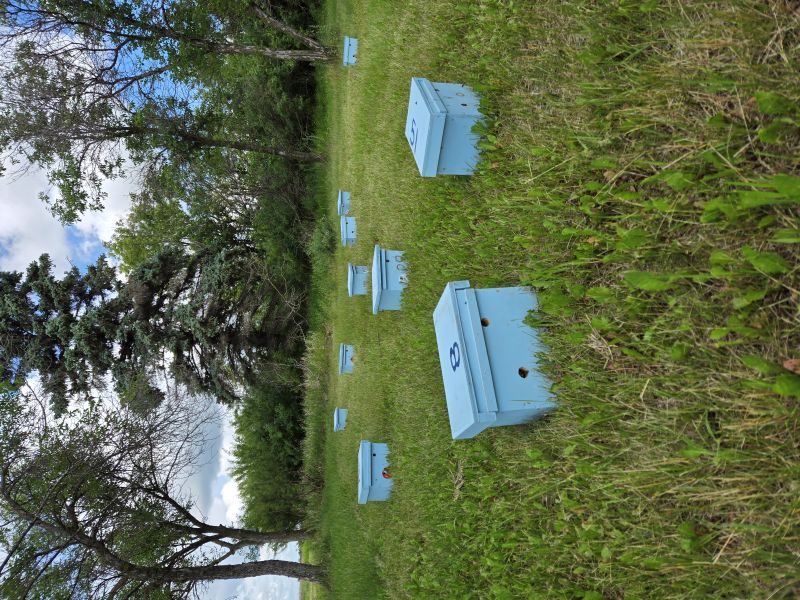· By Angela Seto
The honey flow has begun

Mini hives used for mating our own queens
What's new on the farm:
The honey is flowing! To tell the truth, honey is always flowing throughout the season as long as flowers are blooming. Most of the time, that honey is left in the hive for the bees to eat and feed their growing population.
But this time of year, when we can harvest honey, is when millions and millions of flowers are all blooming at the same time. This coincides with the population of the hive growing to 80,000 to 100,000 bees. The bees go out and collect so much nectar that they can't even consume it all.
But since the colony survives year after year (unlike almost all other bees and insects), their instinct is to store as much food as they can. As the saying goes, "Make hay while the sun shines!"
The winter population of a colony is only 10,000-30,000 bees. They need about 60-90 pounds of honey for the winter. But in Saskatchewan, a single hive can yield over 300 excess pounds of honey during the harvest season.
This isn't the case everywhere. Many places only see yields up to 90 excess pounds of honey per hive. Beekeeping is a give-and-take relationship between beekeeper and bees. We give a lot of effort to the bees to keep them healthy, strong, and provide what they need to thrive.
In turn, the bees are strong enough to forage for excess amounts of nectar that they turn into honey. Our reward is that we get to take the excess honey that these bees make!
A beekeeper's wish: More Rain!
It's not a given that we always get big yields from our hives. The nectar flow depends on the amount of moisture that the wildflowers and crops get in the season. The region around our farm has been facing drought conditions for several years.
That means that even though our hives could be strong, there wasn't much nectar in the fields for the bees to forage. When that happens, the bees might collect enough honey for themselves, but not much extra for us. So we have lower yields or none at all.
Some years it has been so bad that we have to feed them sugar syrup in the fall so they don't starve going into the winter. Each year, the drought worsens the soil conditions for the following year. And we get deeper and deeper into a "moisture-debt." We try to hold on to our sanity by hoping that the next year will be a better one (classic farmer mentality).
This year, we have actually seen higher moisture levels than the previous years. The grass is no longer brown. The trees aren't dying. Unlike the past several years, it looks lush and green on our farm. We get to mow the grass more than once this season.
But we're not out of the woods yet. We keep hoping for more rain, inch by inch. Not just to get a good honey yield, but also to replenish the earth around us that has been suffering for so long. So if you're thinking of us, send a little prayer to the rain gods so that we can continue to satiate our thirsty little corner of the planet!
Thank YOU for your responses
I want to thank everyone who replied to my last email asking about your honey habits and why you choose to have honey in your life. I also want to thank everyone who gives feedback to my emails and shares their stories.
I read every single email. It takes me a little time to get back to everyone, but I promise you that I have enjoyed your comments and shared them with Andrew too.
Refreshing Honey Lemonade
It's summer time which is the perfect time for a refreshing honey lemonade recipe. As a kid I thought lemonade was only made with the powdered crystals (we didn't drink lemonade at home, I only got it at parties!). It took me until I was an adult to realize that I can easily make lemonade at home!
This recipe is only 3 ingredients. One of them is water. The best part is the honey doesn't get heated so you get the full benefits of it in a delicious drink!
Ingredients
- 1 cup lemon juice, freshly squeezed is best (about 1lb of lemons)
- 1/2 cup raw honey, adjust to taste
- 3 cups water
- 1 cup ice cubes
Directions:
- You can add all ingredients to a pitcher and stir vigorously until the honey is dissolved.
- Or you can throw them into a blender and let the machine do the work.
- You can also swap the water for more ice and make a slushy instead.
Enjoy!
Recipe taken from Kitchen Cents.
